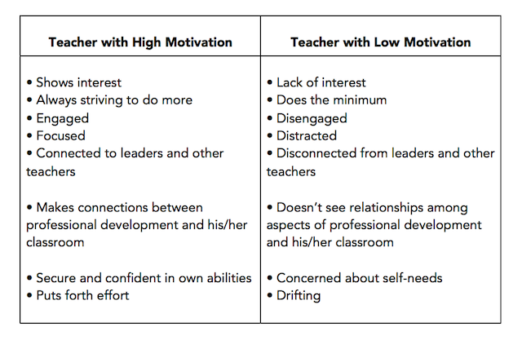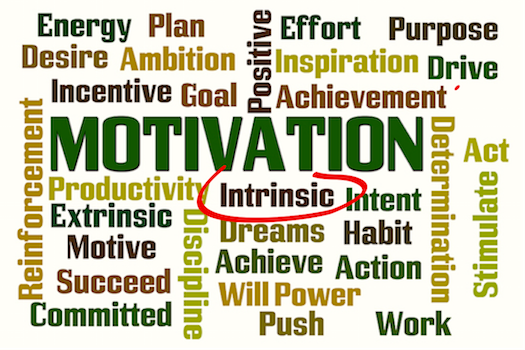School Change Begins with Teacher Motivation

Like it or not, change is part of our lives. No place exemplifies that more than in schools and classrooms where teachers and school leaders strive to meet the needs of every student, to support every family, and to incorporate new and innovative instructional practices.
The pace of change can often feel overwhelming. Those perceptions often create a reluctance to embrace change. Many principals we talk with identify motivation as a key, and they are looking for ways to motivate and engage their teachers.
There are real, observable differences when a teacher is highly motivated. What is the difference between a motivated and unmotivated teacher? Here are some of the characteristics.

Igniting Passion for the Work
There are two main types of motivation: extrinsic and intrinsic. Extrinsic motivation includes all the outside ways teachers are influenced, such as rewards, directives, teacher evaluations, and student test scores. Intrinsic motivation comes from within the teacher.
Extrinsic rewards often yield temporary results, but for long-term impact, leaders must help teachers activate their intrinsic motivation to serve students effectively and earn the respect and cooperation of their peers.
Intrinsic motivation, psychologists tell us, occurs when we act without any obvious external rewards. We find enjoyment in the work or see what we are doing as an opportunity to explore, learn, and further our potential.
Teachers who are intrinsically motivated appreciate teaching for its own sake. They feel some restlessness to learn and attain the feelings of accomplishment that come with skillful teaching.
Intrinsic motivation is powerful. Intrinsically motivated teachers tend to prefer challenging work, are more likely to become confident about their abilities, and believe they can truly make a difference in terms of student learning.
What Contributes to Intrinsic Motivation
Intrinsic motivation has two foundational elements: People are more motivated when they value what they are doing and when they believe they have a chance for success. Let’s look at both of these aspects.
- The work has value
Teachers see value in lots of ways, but the three most impactful are relevance, the type of learning activity, and relationships.
Teachers typically see value through the relevance of what you ask them to do. Relevance, and value, emerge when teachers see a practical application to their learning.
When asked to implement a new initiative or try a new strategy in their classroom, teachers often want to know—what’s in it for me and my students? What’s the payoff? That’s why they ask you, “Why do we need to do this?”
When Barbara works with teachers, she knows they come into her workshops with one key question: “How can I immediately use this information?” Adult learners juggle many demands, and they prioritize activities and their attention based on how something meets their immediate needs. Teachers are more engaged in learning when they see a useful connection to themselves.
Next, there is value in the type of learning activity you are doing. Teachers are generally more motivated by doing something during professional development, rather than experiencing yet another “sit and get” built around lectures and PowerPoint slides.
They are also more motivated when they have ownership in the activity. Rather than simply planning a new initiative yourself, or deciding unilaterally what specific skills to focus on, involve teachers in the decision-making process.

Most teachers need the same from their peers. If they feel isolated from other teachers and from you, they will be disengaged and less likely to see value in what they are doing. If you’ve ever been part of successful teamwork that achieved an important goal, you know about the empowering feelings that come from meaningful relationships.
- Success seems possible.
Teachers are also motivated when they believe they will be successful implementing a new learning. Two things contribute to that motivation.
First, the degree of alignment between the difficulty of an activity and a teacher’s skill level is a major factor in self-motivation. Imagine that you enjoy playing tennis, and you have the chance to compete in a match. Then you discover you’ll be playing against Venus Williams. How do you feel? In that situation, there’s plenty of opportunity for challenge, but it’s probably too much challenge!
This is where well-designed professional development is crucial. When you motivate teachers to implement a new initiative or improve their teaching, remember to also provide the appropriate support to improve their skill level. Scaffolding isn’t just for students.
Prior experience is also an important factor. A teacher is more likely to believe they can be successful implementing a new grouping strategy if they’ve already had success using small groups in their classroom. On the other hand, if a teacher struggles with behavioral issues during group work, they are less likely to try the new strategy.
Another Way to Build Teacher Motivation
Another motivational concept to consider is that of shared success. An individual’s intrinsic motivation is fostered in an overall environment of encouragement. Work to create a culture of shared motivation by asking everyone – teachers, students, assistant principals, custodians, and cafeteria workers to notice the “good” that is happening and to comment on it.
Families can get involved too. Just as teachers share what students are doing well, it’s important for parents to recognize and share the positive experiences they and their children have with teachers.
School leaders need to model this success-sharing behavior. One school where we worked had a way to recognize success by letting everyone take part in honoring the good things going on.
The school’s mascot was a tiger, and the principal created “Paws for Praise” certificates to recognize teachers and students. When the principal saw a teacher making a difference, the teacher received a certificate. Better still, she put a basket of the certificates in the teachers’ mailbox area and encouraged them to write success notes to each other as well as to students.
ALSO SEE
THESE POPULAR ARTICLES
BY RON AND BARB
Motivating Teachers in Challenging Times
Offering Constructive Feedback to Teachers
Leaders Can Kindle the Flame
Motivation is an individual thing, and teachers, as well as other employees, will have different levels of motivation. However, there are things leaders can do to tap into the latent motivation that drew most educators into our profession.
By creating an environment that sparks and kindles intrinsic motivation and ensures that the professionals in our schools see the value of the work and chance for success, we can increase teachers’ support for and willingness to change.
_______________
































Great post! Yes, change begins with motivation…sustained motivation followed by action planning and then action. It can start with one positive action by one person and cause a chain reaction spreading outward to create real change.
Enjoyed this post. We have to also choose teachers who feel they have been “called” to teach. Some unmotivated teachers can interview very well, but when observed, do not carry the enthusiasm of that initial interview. Principals need training to ask the right questions about lesson planning, classroom management, and what they would do in different situations. If you can, observe a lesson as well and perhaps ask for an on-the-spot writing sample.